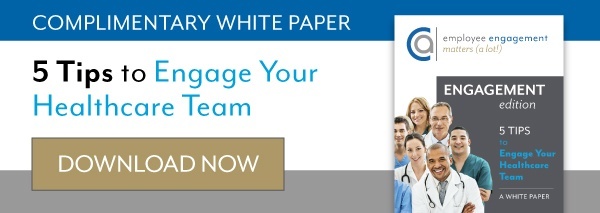The concept of employee recognition is not a new ideology. For many years, healthcare facilities have recognized employees years of service by awarding pins and badge accents, hosting banquets, and providing merchandise-based catalog rewards. Some departments may recognize their own achievements or milestones, but those achievements were never communicated outside of their floor.
What has changed is the idea of implementing a strategic recognition strategy that goes way beyond the number of years your employee has worked for you, and that allows for interdepartmental recognition.
Employee recognition and engagement are based on the notion that your employees need more than an annual "thank you for sticking around." By incorporating Recognition Professionals International’s (RPI) three-dimensional descriptors of recognition your facility, you will be able to build a strong culture of recognition and commitment to employee engagement.
What are the Three-Dimensional Descriptors of Recognition and What Do They Mean?
In order to successfully structure an employee recognition program, your recognition strategy must incorporate formal, informal, and day-to-day recognition.
Formal Recognition
Formal recognition is a structured program with defined processes and criteria linked to your organizational values and goals.
With formal recognition, there is a nomination and selection process. Employees are then recognized publicly during an awards ceremony.
Formal recognition is often celebrated annually and typically reaches 5% to 24% of your organization.
Informal Recognition
Informal recognition is for individuals or teams for progress toward milestones, achieving goals, or project completion.
Celebrations may include points, gifts, or refreshments to celebrate achievements or behavior changes.
It is less structured than formal recognition and typically reaches 25% to 75% of your organization.
Day-to-Day Recognition
Day-to-Day recognition is frequent, ongoing, and informal. It's designed to recognize behaviors that support your organizational values.
All employees have the opportunity to give and receive recognition. It reaches 76% to 100% of your organization.
Examples include verbal recognition, thank you notes, eCards, or Instant Award Cards that can be given by peers or management staff.
How Can I Apply Employee Recognition in My Healthcare Facility?
An employee recognition program gives you the ability to create a culture of recognition across all departments.
By allowing RN’s to recognize their cafeteria workers for providing excellent service via eCards, or giving nursing assistants the ability to earn points for exceptional patient satisfactions scores, or giving all employees the ability to wish each other a happy birthday via social recognition, your facility will increase productivity, patient satisfaction, and profitability.
C.A. Short Company has developed strategic total engagement programs for some of the largest healthcare organizations in the country. We have learned that healthcare facilities need flexibility and measurable benchmarks in order to achieve desired results. By integrating the individual and departmental programs into one total recognition platform, healthcare facilities can easily manage, monitor, and most importantly measure the success of the program as a whole.
Editor's Note: This blog post was originally published in 2015 and has been recently updated.



.png?width=70&name=Untitled%20design%20(11).png)
.jpeg)

.jpg)



SHARE